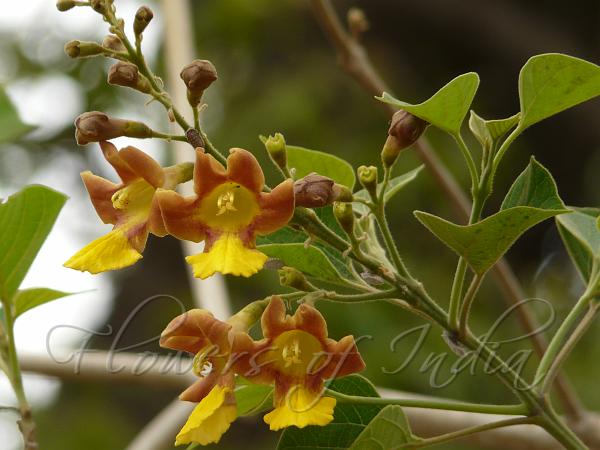|
| Gamhar |
|

|

| File size | 2137152 |
| Original date | 3/28/09 2:16 PM |
| Resolution | 2560 x 1920 |
| Flash | Flash did not fire, auto |
| Focal length | 66.3mm |
| Exposure time | 1/160s |
| Aperture | 4.0 |
| Focus Distance | |
| Metering Mode | Multi-segment |
| Camera make | Panasonic |
| Camera model | DMC-FZ18 |
| Sensor type | OneChipColorArea |
|
|
|
Photo: |
Botanical name: Gmelina arborea Family: Verbenaceae (Verbena family)
Gamhar is a beautiful fast growing deciduous tree occurring naturally
throughout greater part of India up to 1500 m. It is a fast growing tree,
which though grows on different localities and prefers moist fertile
valleys with 750-4500 mm rainfall. It does not thrive on ill drained soils
and remains stunted on dry, sandy or poor soils; drought also reduces it to
a shrubby form. The tree attains moderate to large height up to 30 m with
girth of 1.2 to 4.5 m with a clear bole of 9-15 m. It is a treat to see the
gamhar tree standing straight with clear bole having branches on top and
thick foliage forming a conical crown on the top of the tall stem. Bark
light grey coloured exfoliating in light coloured patches when old, blaze
thick, a chlorophyll layer just under the outer bark, pale yellow white
inside. Flowering takes place during February to April when the tree is
more or less leafless whereas fruiting starts from May onwards up to June.
Flowers occur in narrow branching clusters at the end of branches. The
yellow flower, tinged with brown, is trumpet shaped, 3-4 cm long. The
trumpets flare open into a gaping mouth with 5 distinct lobes.
Medicinal uses: The root and bark of Gmelina arborea are
stomachic, galactagogue laxative and anthelmintic; improve appetite, useful
in hallucination, piles, abdominal pains, burning sensations, fevers,
‘tridosha’ and urinary discharge. Leaf paste is applied to relieve headache
and juice is used as wash for ulcers. Flowers are sweet, cooling, bitter,
acrid and astringent. They are useful in leprosy and blood diseases. In
Ayurveda it has been observed that Gamhar fruit is acrid, sour, bitter,
sweet, cooling, diuretic tonic, aphrodisiac, alternative astringent to the
bowels, promote growth of hairs, useful in ‘vata’, thirst, anaemia,
leprosy, ulcers and vaginal discharge. The plant is recommended in
combination with other drugs for the treatment of snake – bite and
scorpion- sting. In snake – bite a decoction of the root and bark is given
internally.
The root and bark of Gmelina arborea are
stomachic, galactagogue laxative and anthelmintic; improve appetite, useful
in hallucination, piles, abdominal pains, burning sensations, fevers,
‘tridosha’ and urinary discharge. Leaf paste is applied to relieve headache
and juice is used as wash for ulcers. Flowers are sweet, cooling, bitter,
acrid and astringent. They are useful in leprosy and blood diseases. In
Ayurveda it has been observed that Gamhar fruit is acrid, sour, bitter,
sweet, cooling, diuretic tonic, aphrodisiac, alternative astringent to the
bowels, promote growth of hairs, useful in ‘vata’, thirst, anaemia,
leprosy, ulcers and vaginal discharge. The plant is recommended in
combination with other drugs for the treatment of snake – bite and
scorpion- sting. In snake – bite a decoction of the root and bark is given
internally.
Medicinal uses:
 The root and bark of Gmelina arborea are
stomachic, galactagogue laxative and anthelmintic; improve appetite, useful
in hallucination, piles, abdominal pains, burning sensations, fevers,
‘tridosha’ and urinary discharge. Leaf paste is applied to relieve headache
and juice is used as wash for ulcers. Flowers are sweet, cooling, bitter,
acrid and astringent. They are useful in leprosy and blood diseases. In
Ayurveda it has been observed that Gamhar fruit is acrid, sour, bitter,
sweet, cooling, diuretic tonic, aphrodisiac, alternative astringent to the
bowels, promote growth of hairs, useful in ‘vata’, thirst, anaemia,
leprosy, ulcers and vaginal discharge. The plant is recommended in
combination with other drugs for the treatment of snake – bite and
scorpion- sting. In snake – bite a decoction of the root and bark is given
internally.
The root and bark of Gmelina arborea are
stomachic, galactagogue laxative and anthelmintic; improve appetite, useful
in hallucination, piles, abdominal pains, burning sensations, fevers,
‘tridosha’ and urinary discharge. Leaf paste is applied to relieve headache
and juice is used as wash for ulcers. Flowers are sweet, cooling, bitter,
acrid and astringent. They are useful in leprosy and blood diseases. In
Ayurveda it has been observed that Gamhar fruit is acrid, sour, bitter,
sweet, cooling, diuretic tonic, aphrodisiac, alternative astringent to the
bowels, promote growth of hairs, useful in ‘vata’, thirst, anaemia,
leprosy, ulcers and vaginal discharge. The plant is recommended in
combination with other drugs for the treatment of snake – bite and
scorpion- sting. In snake – bite a decoction of the root and bark is given
internally. | Identification credit: Pravin Kawale | Photographed in Delhi, Manipur & Jharkhand. |
• Is this flower misidentified? If yes,